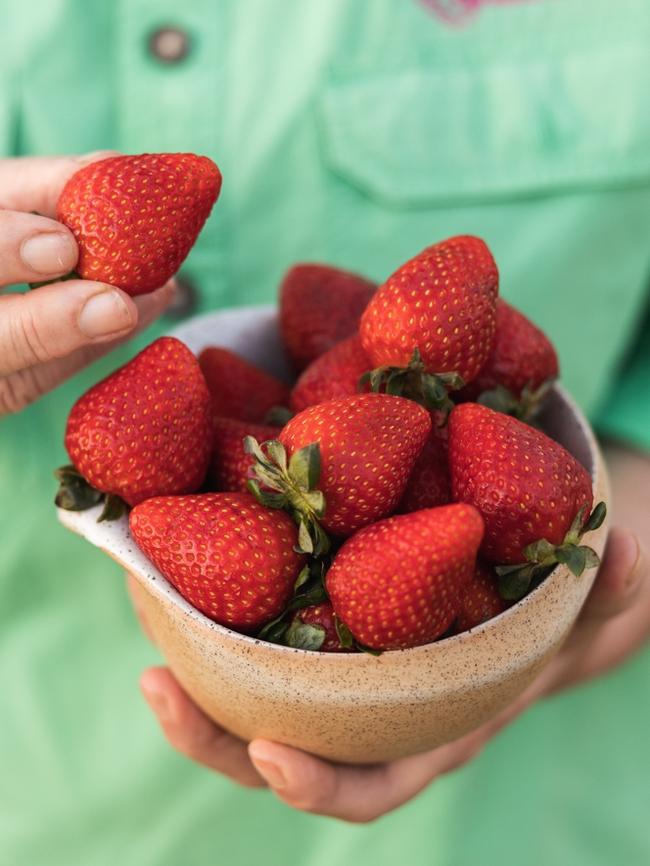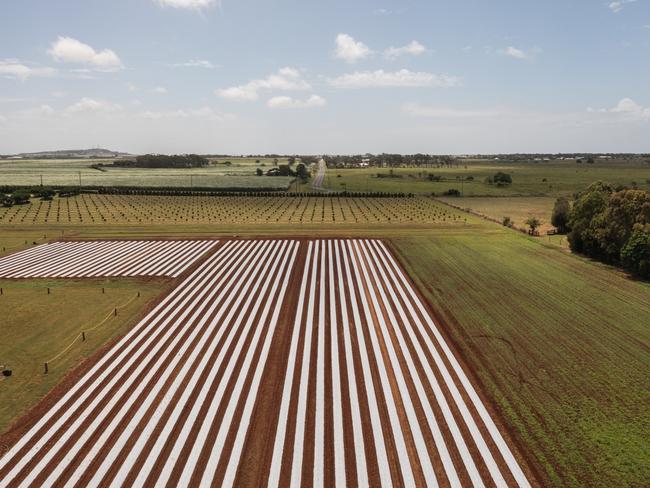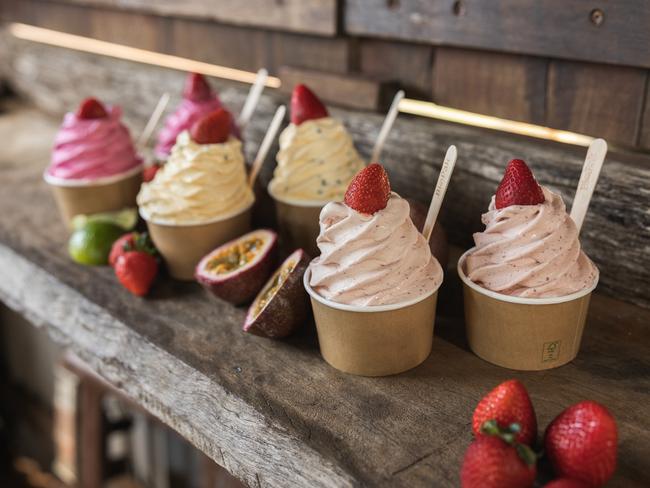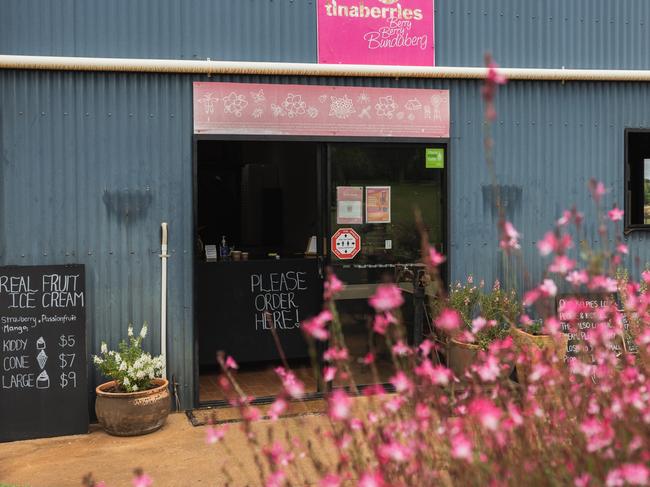Tinaberries: Strawberry growers add ice cream to boost viability
With the market price for their fruit falling below the cost of production, the McPhersons had to reinvent their operation and have soared.

In the labour-intensive and market-challenged field of strawberry growing, Queensland producers Tina and Bruce McPherson have been fortunate to find their sweet spot.
“You either had to get really big or stay small and niche and value-add to survive, which is what we’ve done,” Tina said.
Having ridden the wave of production from small to medium scale and back again over the past two decades, the couple has found the balance of 80 per cent commercial production and 20 per cent agritourism to be their most viable and sustainable management system.
Beginning with 20,000 plants in 2006, their Tinaberries business grew to a peak of 300,000 plants in 2018 but in the past five years has been strategically reduced to 80,000 to 100,000 plants. At the same time, the McPhersons have begun value-adding waste product by freezing fruit, producing ice cream on site and allowing customers to pick their own strawberries from the field.
Being able to control their returns in a number of ways has been instrumental to their financial success.
Meanwhile, a significant focus on environmental stewardship due their proximity to the Great Barrier Reef has returned immeasurable value in sustainability rewards.


THE PERFECT PICK
The McPhersons began growing field strawberries commercially on their 40ha property at Woongarra, between Bundaberg and the Coral Coast, 18 years ago.
Prior to that, they owned and operated a dairy farm in New Zealand, and spent five years offshore in corporate agriculture where they worked in Uruguay on pasture development and also ran a dairy feedlot in Indonesia.
On choosing a suitable location to settle down and raise their young family, Tina and Bruce moved to Australia and carefully selected Woongarra for its climate, proximity to Bundaberg, Brisbane and the coast, and it’s good soil and irrigation water.
The property originally produced sugarcane but a strawberry farm 4km up the road planted a new seed of direction for the McPhersons’ journey in agriculture.
“This man grew the best strawberries we had ever tasted,” Tina said.
“I started by asking him whether he thought that growing strawberries was a good idea. His reaction was “if you don’t mind working seven days a week for the season, it’s a good thing to get into”.
“He was trying to put me off but I said we were used to working as dairy farmers for 16 hours a day, seven days a week, for nine months of the year.”
The strawberry farmer, who was retiring that year, became a mentor to the McPhersons. He was instrumental in helping them get set up and taught them about production and markets.

PRICE POINT PAIN
In 2006, the McPhersons grew their first strawberry crop selling mostly to southern markets.
“We wanted to grow something that we could both be passionate about,” Tina said.
“In hindsight there were other crops that would have been more financially viable.”
They maintain a point of difference by packing gourmet strawberries in 375g or 750g punnets rather than the standard 250g and prefer to sell to independent grocery stores and fruit and vegetable shops.
Every strawberry is hand-picked and hand-packed in their packing shed.
“It sometimes costs more to produce a kilo of strawberries than to buy it,” Tina said.
“The things that make it difficult are labour – it is a highly labour-intensive industry, compliance and price pressure from the supermarkets. Not that we sell to the supermarkets but our return is based on market price, which is driven by what the supermarkets are willing to pay.
“Unfortunately they use strawberries as a loss leader for parts of the strawberry season. The price for 250g will sometimes drop to 0.99 cents. The consumer is paying the equivalent of $4 a kilogram while our cost of production would be $6 a kilogram.
TAKING CONTROL
As industry challenges increased, value-adding waste product became a necessity for the McPhersons to remain economically viable.
“In horticulture you are always going to deal with a waste issue in most crops anywhere between 12 and 20 per cent. That doesn’t mean there is something really wrong with that fruit but it won’t get you a really good return,” Tina said.
They opted to freeze waste product to use in jams and preserves and started to make fresh fruit ice cream on site to sell direct to customers.

“It has been incredibly popular and a great outlet,” Tina said.
“We already had people coming to the farm to buy direct from us anyway so we were already set up for visitors during the strawberry season.”
Selling ice creams began as one day a week but quickly moved to 363 days a year.
“We learnt early on that people weren’t just coming for the ice cream, although it is very good,” Tina said.
They came for the garden setting, to spend time with friends and family and to experience the farm as part of the popular pick-your-own experience.
“Pick your own is ridiculously popular. You can eat as many as you like while picking and they come back and only pay for what they’ve picked in the bucket on a per-kilo rate,” Tina said.
“We might have 100 families come through on a Sunday.”
Agritourism has been invaluable to the McPhersons for helping retain an element of control over their returns, spreading seasonal cash flow and labour management and maintaining relationships with end customers.

ATTENTION TO DETAIL
The strawberry growing process begins in February with plastic mulch and trickle irrigation laid down in rows before planting at the end of March.
Runners are bought from a breeder co-operative at Toolangi in Victoria with two main varieties – Red Rhapsody and Petaluma – the most suitable for their coastal Queensland growing conditions.
Planting is conducted over four weeks, and it takes eight weeks for plants to fruit. Picking runs from May to November with the help of a seasonal workforce.
Plastic is pulled up at the end of the growing season and the fields planted with a green cover crop of sorghum or oats over summer. The crop is chopped back into the soil as green mulch before the strawberry growing process begins again.
Regular agronomic advice, leaf samples, soil moisture probes and “years of trial and error” with fertiliser and water through their irrigation and fertigation systems have helped the McPhersons master their production.
“There is a lot of science behind it and attention to detail. We are working on it all the time to get the best possible berry,” Tina said.
NO BUG-BEAR
Growing sustainable, well-nourished plants that are nutritionally balanced is key to resisting pest and disease challenges, and the McPhersons spend thousands of dollars each year on predatory mites to combat bad bugs.
“We have an entomologist who comes through fortnightly and counts our mite and bug populations, assesses what our requirements are and what our challenges are going to be and then we buy in predatory mites to consume any bad mites that might be a problem,” Tina said.
“If we maintain that whole little ecosystem in there then we are looking after the health of our plants and the environment.”
It also helps reduce chemical and pesticide use, a focus for the McPhersons given their location near the Great Barrier Reef. All run-off is caught in a dam and reused via irrigation. Strict monitoring ensures they do not contribute any run-off to local waterways that go into the reef.
They also have a program replanting some of the lower lying and wetter areas of the farm, previously cleared for sugarcane, with native vegetation including melaleucas, rainforest species and understorey trees to provide habitat for wildlife.
CLIMATE CONTROL
The McPhersons also grow passionfruit, blueberries and raspberries on a smaller scale but all are labour intensive. Passionfruit has been particularly challenging with a very volatile market – an 8kg carton could sell for $20 or $120.
As a result, they have reduced passionfruit vines from 15,000 to 1000 – enough to supply their passionfruit ice cream variety.
Tina and Bruce have more recently begun planting the farm with macadamia trees, which will provide an alternative income with mechanised equipment, requiring less labour input.
“The future of strawberry farming is in protected cropping – tunnels and hot houses – same as the tomato industry has gone,” Tina said.
“That is business savvy. If you can control your climate in a protected cropping environment then you eliminate weather challenges and limit pest incursions.
“Will that produce a less sweet, less fabulous tasting strawberry? Maybe. If you make a comparison to tomatoes, most are grown like that now. On the whole, tomatoes are relatively bland and tasteless compared to what they used to be.
“That’s why people go back to growing for taste so there will always be a place for smaller, boutique farms like ours, but you pay more for that type of product.”




